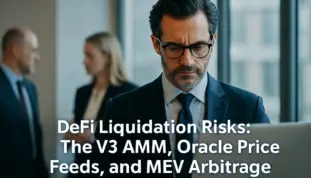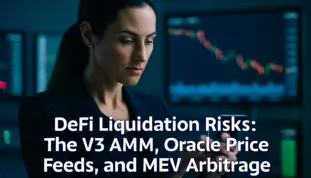DeFi Liquidation: V3 AMM, Oracle Risk, and MEV Arbitrage
The Liquidation Engine: Mastering DeFi V3 Mechanisms and MEV Risk Mitigation
In decentralized finance (DeFi), liquidation is the silent engine that keeps lending protocols solvent. It’s an automated safety mechanism, not a punishment. Yet, for many traders and liquidity providers, the experience of being liquidated feels like a shock — a Liquidation Shock — an instant, algorithmic event that erases a position in seconds. Understanding this phenomenon is the key to mastering risk in DeFi.

Unlike centralized exchanges where margin calls come with human intervention, in DeFi, liquidation happens through smart contracts that monitor collateral ratios in real time. When the value of your collateral drops below the required threshold, your position is instantly seized and sold by automated liquidators. This process is not personal — it’s mathematical, quantifiable, and fully transparent on-chain.
To fully control liquidation risk, you must understand the three fundamental vectors that define it:
- Price Discovery (Oracles): The accuracy and latency of the oracle price feeds that determine when your collateral becomes unsafe.
- Mechanism Design (V3 AMM): The complex liquidity curves and fee structures in protocols like Uniswap V3 that affect collateral valuation and swap execution.
- Profit Motive (MEV): The MEV liquidation arbitrage incentives that drive bots to compete for liquidation opportunities, sometimes increasing slippage and gas cost risks for users.
Before diving into advanced topics like Oracle Price Feed Risk or Liquidation Aggregation V3, we must start with the foundation: how liquidation thresholds are calculated and what they truly mean.
Liquidation Threshold Calculation Explained: Collateral Ratios and Safety Buffers
At the heart of every lending protocol lies a simple yet powerful formula — the Collateral Ratio. It defines how much you can borrow relative to your deposited assets. When this ratio falls below a defined Liquidation Threshold, the protocol automatically liquidates your position to prevent insolvency.

The Collateral Ratio (CR) is expressed as:
Collateral Ratio (CR) = (Value of Collateral / Value of Borrowed Assets) × 100%The Liquidation Threshold (LT) is the point below which your collateral is considered unsafe. It is set by the protocol for each asset, depending on volatility and liquidity characteristics. For instance, stablecoins often have thresholds around 85–90%, while volatile assets like ETH may be closer to 75%.
Let’s consider a simplified example that mirrors how protocols like Aave or Compound define liquidation mechanics:
| Parameter | Value | Explanation |
|---|---|---|
| Collateral Asset | ETH | The asset deposited as collateral. |
| Initial Collateral Value | $100 | The starting value of your deposit. |
| Liquidation Threshold | 75% | When collateral value / borrowed value < 0.75, liquidation triggers. |
| Borrow Limit | $75 | Maximum loan amount before risk begins to accumulate. |
| Liquidation Price Point | $75 collateral value | If ETH price drops 25%, your position becomes eligible for liquidation. |
This table demonstrates how the Liquidation Threshold Calculation is not arbitrary. It’s a direct function of collateral volatility and borrowing exposure. Once your collateral ratio crosses this threshold, smart contracts automatically call liquidators to act — usually through Keeper Bots or Liquidation Aggregators integrated with major DeFi protocols.
Here’s how a liquidation event unfolds in technical terms:
- The protocol continuously monitors your position through oracle price feeds (often powered by Chainlink).
- If the feed detects that your Collateral Ratio has fallen below the Liquidation Threshold, a liquidation transaction becomes eligible.
- Keepers or Liquidator Bots detect this opportunity on-chain and submit a liquidation transaction.
- The protocol repays part (or all) of the debt using your collateral, applying a Liquidation Penalty Calculation (a small percentage taken as incentive for liquidators).
For example, if your $100 ETH collateral drops to $74 and your liquidation threshold is 75%, your position is automatically flagged. The protocol liquidates enough of your ETH to bring your ratio back above the threshold, plus a small penalty — typically 5–10% — to reward the liquidator for stabilizing the system.
From this point, liquidation risk is no longer about luck or market timing — it’s about mathematical thresholds. Understanding these mechanics allows both beginners and professionals to proactively manage exposure and avoid unnecessary losses.
The next layer of complexity lies in how these liquidation triggers depend on the quality and reliability of oracle data — the single point of truth for on-chain valuations. Let’s explore how Oracle Price Feed Risk can amplify or mitigate liquidation exposure in DeFi systems.
Oracle Price Feed Risk: The Single Point of Failure in DeFi
In decentralized finance, the reliability of oracle price feeds is the cornerstone of liquidation accuracy. A DeFi liquidation event can only be as fair as the price data that triggers it. When that data is manipulated or delayed, even the most robust protocols can suffer from cascading liquidations that wipe out healthy positions.
At a technical level, every Aave liquidation mechanism or Compound liquidation mechanism depends on external data providers that deliver real-time market prices for assets like ETH, BTC, or stablecoins. These providers — most notably Chainlink — aggregate data from multiple off-chain exchanges, sign it cryptographically, and feed it to smart contracts on-chain. This system minimizes manipulation but introduces latency, which can be exploited in fast-moving markets.

The critical risk emerges when the price feed becomes a single point of failure. A small error, delay, or temporary price distortion in the feed can cause multiple accounts to cross their liquidation threshold simultaneously, triggering large-scale automated sell-offs. These events can reinforce each other, especially when combined with high leverage and thin liquidity pools.
The TWAP Oracle: Slower but Safer
To mitigate volatility spikes, some DeFi protocols implement a Time-Weighted Average Price (TWAP) oracle. A TWAP oracle computes the average price of an asset over a fixed period — for instance, 30 minutes — rather than relying on a single snapshot price. This technique smooths out sudden anomalies caused by flash crashes or short-term manipulation.
The TWAP Oracle Risk is a trade-off between responsiveness and stability. While TWAP reduces exposure to instantaneous manipulation, it can delay reactions to genuine market movements. In extreme volatility, this delay can cause the system to underestimate risk until it’s too late, leading to multiple delayed liquidations that execute simultaneously once the average catches up.
For example, Uniswap V3 integrates a built-in TWAP oracle that averages prices across liquidity ranges. While it’s highly resistant to single-block manipulation, it’s still vulnerable to long-duration volatility events. Therefore, even sophisticated mechanisms must balance speed, precision, and data integrity.
// Simplified pseudocode for TWAP oracle
function getTWAP(asset, period) {
sum = 0;
for (i in last(period) blocks) {
sum += price(asset, block[i]);
}
return sum / period;
}
This simple function illustrates the logic behind a TWAP oracle — aggregating multiple observations over time to compute a stable reference price. In practice, Chainlink oracles use much more complex aggregation models with weighted averages, cross-verification, and deviation thresholds to ensure resilience.
Flash Loan Liquidation Risk: The Oracle Manipulation Vector
Despite these safeguards, one of the most dangerous forms of oracle-related risk is the Flash Loan Liquidation Risk. Flash loans — uncollateralized loans that must be repaid within the same block — allow attackers to temporarily manipulate on-chain prices by executing massive trades within seconds. If the protocol’s oracle relies on in-protocol price data rather than a robust external feed, attackers can artificially move the price, trigger mass liquidations, and profit from the arbitrage before the oracle corrects itself.
This type of attack was famously demonstrated in 2020–2021 against smaller protocols using single-source price feeds. Attackers borrowed millions in flash loans, temporarily dumped an asset on a decentralized exchange, lowered its price, triggered liquidations, and repaid the loan — all in one transaction. Victims suffered losses not because their positions were fundamentally unsafe, but because the oracle price feed risk had been exploited.
To protect against such vulnerabilities, leading protocols now integrate multi-layered oracles. For instance, Chainlink oracles combine off-chain data aggregation with on-chain validation, while Uniswap V3 provides TWAP oracles that resist short-term manipulation. Aave’s documentation explicitly advises developers not to rely on in-protocol pool prices for collateral valuation — emphasizing external data feeds as the standard of safety.
Oracle Reliability as a Systemic Variable
The systemic importance of oracle reliability cannot be overstated. When oracle feeds lag or diverge, DeFi protocols can enter unstable feedback loops where liquidations exacerbate volatility. This is particularly dangerous in V3 Automated Market Maker (AMM) environments, where liquidity is concentrated within specific price ranges, amplifying the effects of small movements.

Consider a scenario in which a Chainlink oracle updates ETH’s price once every 15 seconds. In a high-volatility event, that’s sufficient time for several blocks of arbitrage, flash loans, and partial liquidations to occur at prices significantly diverging from the true market value. These micro-gaps are precisely where MEV liquidation arbitrage thrives — sophisticated bots exploit them to front-run liquidations for profit.
As the DeFi ecosystem evolves, protocols are exploring hybrid solutions — combining TWAP smoothing, multi-feed redundancy, and cross-protocol validation. The goal is not just to measure price accurately, but to ensure that liquidation triggers happen only in response to genuine, sustained market conditions.
In short, the oracle layer represents the most fragile link in the DeFi liquidation chain. While mechanisms like Chainlink’s decentralized node network and Uniswap’s TWAP feed improve data integrity, they cannot fully eliminate temporal risk. Understanding these nuances is critical for anyone managing large on-chain positions — whether individual traders or institutional liquidity providers.
Having established the price feed as the core input of liquidation mechanics, we now turn to the second major vector of risk — the complexity of V3 AMMs and the influence of MEV liquidation arbitrage on execution efficiency and fairness.
Liquidation Aggregation V3 and the Dark Forest of MEV
The transition from traditional lending protocols to V3 AMM-based architectures introduced an entirely new dimension of liquidation risk. In these environments, price data is no longer defined by a single continuous order book. Instead, it emerges from a network of liquidity positions distributed across price ranges — each with its own depth, volatility exposure, and fee dynamics.
This is where the concept of liquidation aggregation V3 comes into play. Unlike in earlier models (e.g., Aave v2 or Compound), where liquidations were isolated and predictable, V3 protocols distribute price impact unevenly. Liquidators must source liquidity across multiple concentrated ranges, often combining on-chain swaps and flash loans to complete a single liquidation transaction. The complexity of these operations transforms the act of liquidation into a high-stakes, automated competition — the MEV liquidation arena.

Here, MEV (Maximal Extractable Value) becomes the invisible force driving efficiency — and, paradoxically, risk — within DeFi. Every liquidation event is an opportunity for bots to compete for blockspace, reorder transactions, and extract profit from arbitrage created by imbalanced pricing or delayed oracle updates.
Keepers DeFi Role and Automation
In a perfectly functioning DeFi ecosystem, liquidations should occur seamlessly, with bots known as Keepers maintaining system solvency. The Aave liquidation mechanism, for instance, relies on Keepers — external agents that continuously scan the blockchain for undercollateralized positions.
Keepers act as decentralized system guardians. Their job is to detect when a user’s collateral ratio has fallen below the liquidation threshold and immediately trigger a transaction that repays part of the loan using the collateral. In return, they earn a small reward, known as the liquidation penalty.
Modern Keepers are not simple scripts. They are optimized, gas-efficient bots running custom algorithms that prioritize transactions based on profitability and probability of success. They often operate in highly competitive environments — a mempool where hundreds of bots watch for the same liquidation opportunity.
To outpace competitors, advanced Keepers employ techniques such as:
- Private RPC endpoints to bypass the public mempool and prevent front-running.
- Simulations using flashbots bundles to test liquidation profitability before broadcasting.
- Sandwich protection strategies to ensure their liquidation transactions are not reordered or censored.
This automation layer — the Keeper network — forms the operational backbone of modern liquidation aggregation V3 systems. Without it, the efficiency of risk mitigation in protocols like Uniswap V3 and Compound would collapse, leading to liquidity gaps and cascading defaults.
The MEV Profit Motive: Liquidation Arbitrage in Action
While Keepers act as stabilizers, MEV liquidators operate as profit-driven entities. Their motivation is not protocol stability, but arbitrage extraction. Whenever a liquidation opportunity appears, these bots race to include their transaction in the next block, often paying exorbitant gas fees to miners or validators to gain transaction priority.

This process — known as MEV liquidation arbitrage — occurs when multiple liquidators attempt to execute the same liquidation transaction simultaneously. The winner earns the liquidation penalty, while the losers waste gas and time. This constant competition creates a “Dark Forest” dynamic, as coined by researchers from Flashbots: a hidden war where every actor operates in secrecy to avoid detection or interception.
The sequence typically unfolds as follows:
- An oracle update flags a position as eligible for liquidation.
- Multiple bots detect the opportunity and prepare transactions simultaneously.
- Each bot simulates profitability and gas requirements.
- Bots broadcast transactions privately via Flashbots bundles to avoid exposure in the public mempool.
- The highest-paying transaction is prioritized and executed by a validator.
This zero-sum environment has profound implications for system-level efficiency. On one hand, it guarantees rapid liquidation of unhealthy positions, maintaining solvency. On the other, it introduces unpredictable gas spikes and fairness concerns — users may see their transactions delayed or censored due to MEV races around profitable liquidation events.
Liquidator Bots Optimization
To survive in this hypercompetitive landscape, liquidator developers continuously refine their algorithms for liquidator bots optimization. This optimization spans several layers of technical sophistication:
- Gas optimization: Efficient smart contract design reduces execution costs, maximizing net profit per liquidation.
- On-chain simulation: Bots run dry-runs of potential liquidations using RPC simulation endpoints to verify profitability before execution.
- Cross-protocol scanning: Advanced aggregators monitor multiple protocols (Aave, Compound, MakerDAO) simultaneously to identify the highest-yield opportunities.
- Flash loan bundling: Bots utilize flash loans to source liquidity instantly, repaying them within the same block after completing the liquidation.
These optimizations are not trivial — they form a crucial layer of the DeFi liquidation engine. Efficient bots enhance market stability by ensuring that undercollateralized positions are closed quickly, preventing debt contagion. However, they also raise philosophical questions about centralization: the most profitable liquidators often control disproportionate influence over protocol safety, introducing new power dynamics into otherwise decentralized systems.
In practice, protocols balance this by limiting liquidation penalties and designing fair-play mechanisms. Aave, for instance, caps the incentive to avoid encouraging over-competition that could destabilize the system. Uniswap V3’s concentrated liquidity model, meanwhile, allows liquidity providers to manage ranges in a way that indirectly controls exposure to liquidation cascades.
The V3 Complexity: Liquidity Fragmentation and Execution Risk
V3 AMM architecture introduces a phenomenon known as liquidity fragmentation. Because liquidity is concentrated in specific price intervals, large liquidations can significantly shift prices within those ranges. This makes execution more complex — liquidators must aggregate liquidity across multiple ticks, often executing a chain of swaps across different pools to acquire the repayment asset.
The interaction between oracle latency, concentrated liquidity, and MEV competition defines the operational risk surface of modern DeFi systems. Each factor amplifies the other: a delayed oracle update can cause MEV bots to exploit price discrepancies, which in turn depletes liquidity ranges faster, increasing slippage and reducing efficiency.
To illustrate, consider a liquidation scenario involving Uniswap V3 and Aave:
- Aave flags a position for liquidation based on Chainlink’s latest price feed.
- A liquidator bot triggers a flash loan, using borrowed USDC to repay the borrower’s debt.
- The bot then swaps seized ETH collateral on Uniswap V3, traversing multiple liquidity ranges to find optimal execution.
- Other MEV bots detect the swap path and attempt to front-run it, inflating gas prices and reducing profitability.
Such sequences unfold in milliseconds, with hundreds of bots competing for microsecond advantages. The result is a dynamic yet fragile equilibrium — DeFi’s liquidity engine functioning at full throttle, but always on the edge of overload.
Ultimately, understanding liquidation aggregation V3 is not about code alone — it’s about systems thinking. The interplay between oracles, keepers, and MEV liquidators defines how resilient or brittle a protocol is under stress. The more complex the automation, the higher the stakes of failure.
With these dynamics in mind, the next step is to explore how both professionals and beginners can mitigate these intertwined risks — from maintaining higher collateral buffers to leveraging oracle diversity and automated monitoring tools.
Mitigation Strategies: How to Survive the Liquidation Engine
Understanding the mechanics of liquidation aggregation V3 is only half the challenge. The other half lies in mitigating the risk — developing strategies that help both users and developers protect capital, maintain protocol solvency, and ensure fair participation in the DeFi liquidation environment.
Mitigation does not mean avoiding liquidation entirely — rather, it means designing systems and behaviors that reduce the probability and impact of liquidation events. Let’s explore the most effective approaches used by professionals and researchers across the ecosystem.
1. Maintaining a Healthy Collateralization Ratio
The most direct defense is simple: over-collateralization. In volatile markets, keeping a safe collateral buffer prevents positions from being liquidated during price swings. However, the optimal buffer depends on asset volatility and protocol parameters.
The table below illustrates a recommended margin of safety for several major DeFi assets, based on historical volatility and liquidation thresholds from Aave and Compound.
| Asset | Protocol | Liquidation Threshold | Recommended Safety Margin | Rationale |
|---|---|---|---|---|
| ETH | Aave V3 | 82.5% | 70–72% | High volatility during rapid market downturns. |
| WBTC | Compound | 75% | 65% | Correlated with macro shocks; requires deeper buffer. |
| USDC | Aave | 90% | 80% | Stable asset but subject to peg risk during liquidity crunches. |
| LINK | Aave | 75% | 65–68% | Medium volatility; oracle sensitivity to cross-chain feeds. |
These figures serve as practical guidance. A 10–15% buffer below the liquidation threshold can prevent forced liquidations during high gas spikes or oracle delays.
2. Diversifying Oracle Dependencies
Most liquidations are triggered by oracle price feeds. A temporary lag or incorrect update can incorrectly flag a healthy position as undercollateralized. To mitigate this, advanced protocols integrate multiple oracle sources (e.g., Chainlink, Pyth, and Tellor) and use medianized pricing.
Developers can also implement time-weighted average price (TWAP) mechanisms to smooth out short-term price manipulation and prevent liquidation based on transient volatility. This is especially relevant for Uniswap V3 pools, where concentrated liquidity can exaggerate local price movements.
3. Automated Liquidation Alerts and Monitoring Tools
For retail and professional users alike, monitoring automation is essential. Several open-source and commercial tools exist to notify users before a liquidation event occurs. Examples include:
- DeFiLlama – portfolio tracker with collateral ratio monitoring.
- Zapper – DeFi dashboard with live liquidation alerts.
- InstaDapp – allows proactive refinancing between protocols to prevent liquidation.
These platforms connect directly to on-chain data, using API endpoints and real-time updates to signal when a collateral ratio approaches the threshold. Developers can also build custom Telegram or Discord bots using JSON-RPC feeds to track specific wallet exposures.
4. Using Automated Rebalancing and Safe Borrowing Protocols
Protocols like MakerDAO’s DSR or Instadapp’s DeFi Smart Accounts offer automated debt management features. These systems can autonomously repay or refinance loans when a user’s risk level rises. This automation reduces liquidation exposure while maintaining capital efficiency.
Another emerging solution is auto-compounding vaults — smart contracts that periodically rebalance collateral ratios across protocols. For instance, a vault may migrate assets from Compound to Aave depending on changing interest rates and collateral requirements.
5. Developer-Level Mitigations: Circuit Breakers and Governance Controls
From a protocol perspective, developers have several tools to minimize systemic liquidation risks:
- Dynamic liquidation thresholds: Adjust collateral parameters based on on-chain volatility metrics.
- Oracle circuit breakers: Temporarily freeze updates during extreme price movements to prevent cascading liquidations.
- Keeper throttling: Rate-limit the number of liquidation transactions per block to reduce MEV congestion.
- Decentralized insurance modules: Allocate part of protocol revenue to a safety fund covering unexpected liquidation losses.
These measures align with the principle of graceful degradation — systems that fail predictably under stress rather than catastrophically. By integrating automated throttles and fallback mechanisms, protocols can absorb shocks without triggering mass insolvency.
6. MEV Mitigation: Fair Ordering and Private Transactions
As discussed earlier, MEV competition can distort liquidation markets and penalize honest participants. To counteract this, several mitigation approaches are being tested:
- Private mempools via Flashbots Protect to prevent front-running.
- Encrypted transaction submission using SUAVE or similar privacy-preserving systems.
- Batch auction models where multiple liquidation bids are executed simultaneously to ensure fairness.
- On-chain reputation systems to reward reliable liquidators with lower fees or higher priority.
Each of these techniques addresses one dimension of the “Dark Forest” problem — ensuring that DeFi’s liquidation machinery remains efficient yet equitable.
7. Educational Awareness and User Behavior
Ultimately, technology alone cannot eliminate risk. The final mitigation layer is education. Users who understand liquidation mechanics — collateral thresholds, gas markets, and oracle latency — make better borrowing decisions and avoid unnecessary losses.
Projects that invest in transparent documentation and real-time dashboards help create a more sustainable ecosystem. As the DeFi space matures, literacy about liquidation aggregation V3 and MEV dynamics will become a core component of user safety.
Conclusion: Engineering Resilience in DeFi
Liquidation aggregation V3 is the invisible engine of modern decentralized finance — a sophisticated system that balances incentives, automation, and risk at unprecedented scale. From Keepers to MEV liquidators, every component contributes to systemic stability, yet also introduces new vulnerabilities.
The future of DeFi depends on one key principle: resilient design. Developers must build protocols that anticipate volatility, tolerate oracle delays, and distribute liquidation power fairly. Users, in turn, must adopt disciplined risk management — over-collateralizing, monitoring positions, and understanding how automation impacts outcomes.
By combining technological innovation with transparency and education, the DeFi ecosystem can evolve from reactive liquidation defense to proactive solvency assurance — where stability is engineered, not left to chance.
Disclaimer
This article is provided for educational purposes only and does not constitute financial, investment, or technical advice. DeFi systems are experimental, and participants should perform independent research and risk assessments before deploying capital.
